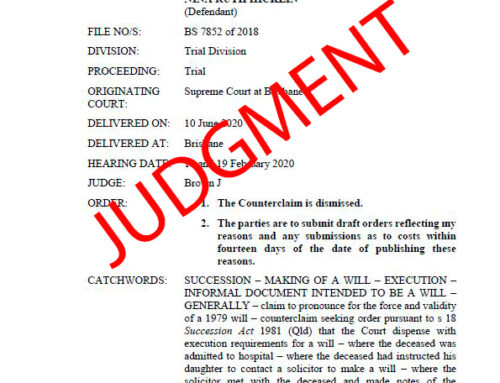A testamentary trust is a trust that is created by the terms of your Will rather than by way of a Trust Deed or an Order of a Court. There are a range of testamentary trusts that are able to be created by your Will.
Testamentary trusts can enhance the value of the inheritance that you are leaving your intended beneficiary or beneficiaries. Testamentary trusts allow you to protect an intended beneficiary who might be vulnerable because of their age or inadequate decision making capability and can allow you, if properly drafted, to rule from beyond the grave to a certain extent. The rationale for including one or more testamentary trusts in a willmaker’s Will is for asset protection for the primary beneficiary of that trust.
The protection offered by a testamentary trust against creditors of the primary beneficiary is significant. Further, testamentary trusts, in practice, offer an increased level of family law asset protection for the primary beneficiary in the event of a marriage break-up. The testamentary trust is not, however, an absolute protection.
Further, tax savings may arise as a result of the operation of the testamentary trust. This advice is split into five separate sections, namely:
- Asset protection;
- Marital breakdown;
- Income tax advantages;
- Capital Gains Tax advantages; and
- Disadvantages of Testamentary Trusts.
Creditor Asset Protection
A beneficiary who receives an outright inheritance from a deceased estate or is absolutely entitled to all or part of the estate assets is said to have property that is divisible property pursuant to Section 116(1) of the Bankruptcy Act 1966. There are some exemptions contained in Section 116(2) of the same Act such as proceeds of life insurance policies, superannuation death benefits and certain compensation payments.
The gift of a testamentary trust as a default option means that the primary beneficiary is not required to inherit assets personally. This is an attractive gift for a beneficiary who faces the prospect of bankruptcy. The primary beneficiary can still exercise control of the inherited assets as trustee or appointor of the testamentary trust or in the event of an insolvency or health or some other crisis being in place when the willmaker dies or subsequently occurring after the willmaker has passed away the trust can be controlled by a “friendly party” who is not associated with or representing any of the creditors of the primary beneficiary.
Whilst there are anti-avoidance provisions found in Section 120 and 121 of the Bankruptcy Act those anti-avoidance provisions are not usually an issue for testamentary trusts provided the willmaker’s estate is solvent at the date of their death. The anti-avoidance provisions are not generally an issue for testamentary trusts because it is the willmaker that has created the trust not the bankrupt and the bankrupt cannot, in our view, be accused of transferring assets away from personal ownership.
Marital Breakdown – Family Law Considerations
The Family Court has an inherent discretion to disregard a trust, company or other ownership structure and to treat assets as part of a joint matrimonial pool of assets notwithstanding the formal legal ownership. The Family Court can make Orders that are binding not only on the parties to the relationship in question but on third parties such as relatives, lawyers, accountants and others.
A fully discretionary testamentary trust is normally considered to be a financial resource of the primary beneficiary for the purposes of a division of matrimonial assets pursuant to the Family Law Act. Those assets will, therefore, be taken into account when the jointly owned assets of the parties are being divided.
The testamentary trust structure offers an increased level of asset protection for the primary beneficiary on the basis that it is rare for the Family Court to order the division of a fully discretionary testamentary trust be divided between the parties of the marriage or domestic relationship. We have, in the past, been instructed to increase the level of protection against potential Family Court Orders for fully discretionary testamentary trusts by some clients by specifically excluding domestic partners of descendants as a class of potential beneficiaries of the testamentary trust.
Those exclusions generally reduce the income tax effectiveness of the trust because pre-tax income cannot be split with the domestic partner of the primary beneficiary. The Family Court has not yet to our knowledge ruled on a testamentary trust with such an exclusion, however, it can be said that the Court has the power to order assets be transferred first to the primary beneficiary and then from the primary beneficiary to the other party to the marriage or domestic relationship.
If Family Law considerations are particularly relevant then the form of the testamentary trust can be altered to provide a greater level of protection. That greater level of protection will reduce the control of the assets in the testamentary trust for the primary beneficiary.
Income Tax Advantages
Ordinarily, trust income payable to minor beneficiaries is subject to penalty tax rates due to the non-personal exertion income test and a penalty tax rate is applied[1]. Fortunately, pursuant to Section 102AG(2)(a) of the Income Tax Assessment Act 1936, testamentary trusts are able to distribute income to minor beneficiaries, i.e. excepted income, and not subject to the penalty rates referred to above.
The advantage then, based on the tax rates for the 2015/2016 financial year, is that a minor beneficiary of a testamentary trust, your grandchildren for instance, with no other income, can receive the first $18,200.00 of income tax free, and then pay the marginal rate of 19% (before the Medicare Levy) for income from $18,201 to $37,000 and a rate of 32.5% starting at $37,001.00 to a maximum of $80,000.00.
The potential for tax savings from income of a testamentary trust which is being spent on a child or grandchild instead of forming part of the adult’s income may be significant. The moneys distributed to the minor child or grandchild can be used effectively to subsidise education and maintenance of the child or grandchild legitimately.
There are anti-avoidance provisions contained within the Income Tax Assessment Act where the testamentary trust is funded from sources other than income earned from capital obtained from the deceased’s estate.
Capital Gains Tax Advantages
Capital Gains Tax or CGT can create particular challenges. Those challenges can be made easier to manage through the use of a testamentary trust. The transfer of assets from the ownership of the deceased to the executor or administrator of the estate and then to the trustee of the testamentary trust will not trigger a Capital Gains Tax event.[2] The transfer of a CGT asset from the executor or administrator of a deceased estate to another trust may trigger a CGT liability.
Disadvantages of Testamentary Trusts
In some instances testamentary trusts are simply not viable. In some instances the beneficiary may not want a testamentary trust. For example, the beneficiary may be of pension age and would prefer to add the capital to their superannuation to increase their income stream.
The testamentary trust may be fixed and may cause issues for pensioners or lack the flexibility required to deal with future changes to the relevant tax legislation. The main residence CGT exemption might not apply where a property that the principal beneficiary will live in forms part of the testamentary trust. Similarly, the principal residence exemption in relation to land tax will generally not apply.
There also needs to be sufficient funding for testamentary trusts to be viable when compared to the number of primary beneficiaries. Testamentary trusts are not applicable in all circumstances and careful planning needs to take place to ensure that the testamentary trust has the desired effect.
Contact Details
Contact us to discuss your testamentary trust and other estate planning matters by phoning 1800 000 993 or by email info@cookehutchinson.com.au
Disclaimer
The advice contained in this document is general legal advice only. It is not specifically tailored to your circumstances. We urge you to take advice specific to your circumstances prior to relying on any advice contained in this document.
[1] See Section 102AG (1) Income Tax Assessment Act 1936
[2] See Australian Taxation Office Practice Statement PS LA 2003/12





